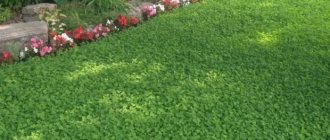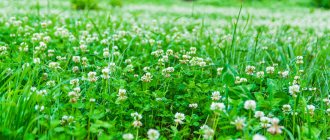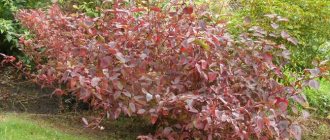Varieties and varieties
Before planting white clover, you need to choose a variety suitable for your lawn. There are several varieties of the plant:
- Meadow - has a high stem up to 50 cm and pink flowers. A distinctive feature is light spots in the middle of the leaves.
- Creeping, or lawn, is a squat variety with a short stem. Unpretentious. Planting and caring for white creeping clover is easy, even for a beginner.
- Mountain is a plant with a stem up to 60 cm long and large light flowers.
- Red is an unusual variety with bright red flowers and emerald leaves.
For decorative purposes, lawn varieties with light colors are most often chosen:
- Atropurpurea - has red leaves with a green edge. Looks unusual and grows well;
- Purpurascens with reddish-brown leaves of an unusual four-leaf shape;
- “Barbian” - quickly sprouts, is not afraid of frost, and is resistant to diseases;
- the Swedish hybrid blooms with whitish-pink flowers. It blooms even in September, until the middle of the month;
- "Liflex" - blooms early and abundantly;
- “Meadow” - low-growing, dense, well-rooted;
- "Nanook" and "Rivendell" are highly decorative varieties with large flowers;
- “Tasman” is unpretentious, recovers quickly, is not afraid of diseases and cold winters;
- "Pipolina" is a microclover with small leaves and small flowers.
The number of varieties is constantly growing, which allows you to choose the appropriate option for sowing in your garden plot or near your home in the garden.
Lawn Features
The lawn with white clover is called "Sloth". Reviews confirm that the plant is added to the grass mixture to soften the coating. This type of lawn is good for arranging children's lawns with slides, swings, benches and houses.
Creeping clover is a low-growing plant, so many gardeners do not prefer to cut it. But they tolerate haircuts well. The minimum recommended mowing height is 3-4 cm, and the maximum is 10-12.
Advantages and Disadvantages of White Clover
Advantages of clover:
- Beautiful appearance with minimal maintenance. Plants form a continuous growth through which weeds do not break through.
- This lawn grass is a legume, therefore it is rich in nitrogen, which means it can be used as green manure.
- Honey plant - arriving bees pollinate fruit plants, increasing the yield.
- After mowing, it becomes nutritious food for animals.
- Aesthetic - clover plantings are suitable for decorating paths, creating lawns, tree trunk circles, “living borders”, photos of which can be found on the Internet.
Flaws:
- It spreads and spreads quickly.
- After mowing it looks unpresentable.
- When grown, other plants survive from their territory.
This crop has many more advantages than disadvantages, so sowing it on your plot will be the right decision.
Description
Plant from the legume family: annual and perennial:
- Clover grows up to half a meter. Ball flowers are white, red, with many shades.
- Leaves of three blades are extremely rare 4. It is not for nothing that the translation from Latin means trefoil (trifolium). Popular wisdom says that finding a four-leaf clover brings good luck. When it’s dark, the leaves “sleep” and stretch upward, lining up lengthwise. With the onset of dawn, they bloom.
- The roots are strong and sometimes become woody.
- Clover is pollinated by bees and bumblebees. After flowering, a bean is formed containing no more than two seeds (yellow or purple).
- Special bacteria living on clover roots feed the soil with useful minerals, such as nitrogen.
Previously, Russian people called the plant kashka. And for good reason. There was so much nectar in the flowers that it flowed down the stem. Clover is one of the valuable forage crops, nutritious for livestock. It does not rot in the hay and grows quickly after mowing.
At first the plant grows slowly. Fully develops by the age of two.
Planting white clover in open ground
It is not difficult to sow plants in open ground. Maintenance is also hassle-free. The only task is to prevent uncontrolled spread throughout the site.
Many people are interested in when to sow creeping white clover seeds for the lawn - in spring or fall. When to plant white clover, decide for yourself: with proper care, both autumn and spring plantings are equally successful. However, remember that fall sowing is carried out four weeks before the first frost. The time when red clover is sown coincides with the time of planting the creeping variety.
Site selection
Plants grow well on a flat, sunny surface. In the shade they develop poorly and die.
Soil preparation and sowing
Before planting clover in the fall or spring, the ground is dug up and loosened, and it is better to do this a month before the planned sowing, when you can remove the grown weeds, and repeat digging and loosening 2-3 days before the due date.
The seeds of this crop are very small and light, so before planting they are mixed with sand, sawdust and soil, taken in equal proportions. At 90 sq. m area will need 50–60 g of seeds. Sowing of clover in autumn or spring is carried out by broadcasting. After planting, you need to manually level the ground with an inverted rake.
The place where clover is sown is watered in autumn or spring and watering is repeated daily until the first sprouts with leaves appear. Typically this process takes 2 weeks.
Landing
In nature, this perennial plant does without weeding and fertilizing. Therefore, at home there are no special problems with it - clover is quite tenacious.
For planting, it is better to choose a well-lit place (slight shade is allowed).
Seeds are used for cultivation. You can collect them from two-year-old plants. But it is better to purchase it in a specialized store. Some gardeners divide tall bushes. But such plants do not take root well.
- The soil should first be loosened and fertilized with organic matter.
- For 1 sq. m of sown area requires about 335 seeds. It is better to soak the seeds for at least 1 hour before planting.
- Planting material should be mixed in a large container with soil. And spread in an even layer over the entire area.
- Then the seeds should be covered with a not very thick layer of soil (about 1 cm).
- Water using a hose fitted with a fine spray nozzle. The soil should be well moistened for 7 days.
- The first shoots will appear in 2 weeks.
When sowing by hand, the lawn will not be uniformly thick and even. Clover is a perennial plant. But after 3 years it should be sown again.
Planting should be done before mid-summer. Otherwise, the clover will not have time to gain a good foothold before the weather gets colder.
Plant care
Clover does not require special care, grows well and quickly recovers after trampling and mowing. The plants are soft to the touch, and it is pleasant to walk on such grass barefoot.
Watering
When sowing clover before winter or spring, frequent watering is not required; it is enough to turn on the sprinkler 2-3 times a week. In cloudy, rainy weather there is no need to water at all. It is important to ensure that the soil does not become damp, otherwise the leaves will rot.
Weeding and removing dried flowers
The sown area must be weeded so that weeds do not clog the sprouts. Subsequently, the grown clover grass itself suppresses weeds. Darkened flowers are picked off, and if there are too many of them, the lawn is trimmed.
A haircut
The first year the sown area is not cut. They start doing this from the second year. The resulting green mass can be used as animal feed or mulched in beds. After mowing, the lawn surface looks unaesthetic, but is restored very quickly.
Some varieties are difficult to trim. For those who don't want to trim, it's better to choose low-growing microclover, which doesn't need to be trimmed at all.
Fertilizer and feeding
Plants themselves release useful nitrogen, so they are not fertilized, except when the crop grows on very poor soils. In this case, 0.5 kg of superphosphate and 0.5 kg of potassium fertilizers are added per hundred square meters. Plants in cold climates are also fed, as this increases their frost resistance. Crops respond well to organic fertilizing, so they can be watered with diluted manure.
Having decided when to sow clover - in autumn or spring, you can speed up the growth of the crop by soaking the seeds in the growth stimulator "Epin" or potassium permanganate before planting and drying them thoroughly. Then they will grow up to heat or frost.
Plant propagation
Clover reproduces by seeds, which ripen after the flowers dry. Seeds are stored for a long time if they are stored dry and the required humidity in the room is maintained. Grass also reproduces by roots.
Diseases and pests
- Fusarium is a fungal disease manifested by rotting roots. For treatment, a 1% suspension of colloidal sulfur is used.
- Rust is caused by a fungus. Brown spots appear on the leaf surface, which spread throughout the plant, leading to its death. The disease is treated with a mixture of lime and ground sulfur. Heavily infected plants are mowed down and burned.
- Typhulosis is another fungal disease that affects not only this plant, but also alfalfa. The stems dry out and break off. Antifungal drugs are used for treatment.
Dodder, a parasitic climbing plant that is destroyed by spraying with a 60% nitrafen solution, also poses a danger to the crop.
Pests - larvae of click beetles, darkling beetles, cutworm caterpillars, pollen eaters, root weevils - are destroyed with insecticides. According to reviews, the drugs “Diazinon”, “Malathion” and “Fozalon” show high effectiveness in the fight against these insects.
Home care
Sour clover (oxalis, lucky clover) pleases with its flowering in winter. Quite unpretentious in care.
Where to place
The flower will feel best in a well-lit place. Light should be distributed evenly over the entire surface of the plant. When there is a lack of light, the sorrel tree stops blooming. And soon dies.
Optimal temperature
The plant should not be placed in places with drafts. With regular watering and fertilization, a temperature of 20 to 24 degrees is suitable for sorrel.
During rest, the temperature should be reduced to 18 degrees.
Subtleties of care
In order for the plant to grow well, it must be watered abundantly and the leaves must be sprayed. These conditions are especially important during the period of active growth and appearance of flowers.
All species require regular fertilizing with mineral fertilizers and loosening.
Growing
Clover is the most unpretentious plant. The main thing for him is good constant soil moisture. The plant should be watered once every 7 days. Excessive moisture can negatively affect the plant. Therefore, watering should be moderate.
Trefoil produces nitrogen on its own. Therefore, it does not require large amounts of fertilizer. Sometimes a clover lawn needs to be thinned out a bit. It is better to plant it in areas where cereals or potatoes previously grew.
Clover is considered an effective remedy for fighting all cancers.
When to sow clover?
There are two ways to sow clover in the spring; you can use either of them.
- Clover can be sown on a prepared surface “piece by piece” - in the early spring morning, when the snow has not yet completely melted and freezes into a thin crust at night. Seeds are sown without planting directly on a crust of ice. As the temperature rises during the day, the crust melts and small seeds, along with water, are drawn into the soil.
- In April, when the average air temperature is around +10+13 degrees, you can sow clover in the usual way with shallow seeding into the ground. In this case, it is necessary to monitor soil moisture.
Sowing is done in late August - early September so that the clover has time to sprout and take root well before frost.
In this case, it is necessary to accurately guess the sowing time so that the seeds do not have time to sprout, but overwinter in the ground. Shoots appear early in spring. The seed rate for winter sowing is doubled.
Care of seedlings.
In the first year, the clover lawn is not very decorative and does not bloom. Its main enemies are weeds. If the area was not treated with Roundup before laying the lawn, then regular hand weeding or spot treatment of weeds with herbicides (applied to the plant with a paint brush) is necessary. After sprouting, clover can be treated with Lemur, Bazagran, Agritox, Agristar.
When planting in spring, mowing the lawn is not required in the first year, but regular watering is required.
In the second year, clover grows well, filling almost all the voids, its root system strengthens, and the plant begins to bloom. When the height reaches 10 cm, it is recommended to make the first haircut.
A haircut
Often, after mowing, a clover lawn is disappointing with dry stems and uneven color, but after a couple of days the appearance is restored. Unattractiveness is characteristic of the pink shamrock. The cropped white look looks like a neat green rug.
No careful care required. For cutting, it is better to use a trimmer or a gasoline lawn mower. The cover is too dense for the lawnmower. The result is wavy and ugly.
It is enough to cut the white variety once every half month. For wild-looking meadows, treatment twice a season is sufficient. You should get rid of 4 cm of the top layer.
Interesting facts about clover
All clovers bloom only for 2-3 years, and live for different periods of time. Red clover has a life expectancy from 2-3 to 10-15. In meadows, in natural conditions, from time to time (usually after 3-4 years) the so-called clover years occur. During these years, clover is almost the main plant in the meadow, and in subsequent years it almost completely disappears.
In the photo: Arable clover (Trifolium arvense) is an annual pubescent plant up to 30 cm high.
What kind of trouble can clover cause?
It is imperative to consider the disadvantages of trefoil carpets:
- fading brown heads must be removed periodically;
- after rain, the lawn takes a long time to dry out due to its dense structure;
- high air humidity makes the surface slippery; especially dangerous on slopes;
- the plant crawls to other flower beds and new territories; it is difficult to get rid of it;
- due to the tight closure of the leaves, the layer at the roots is constantly wet; fungal infections spread quickly;
- nitrogen-containing nodules attract harmful insects, click beetles;
- fragrant flowers delight not only people, but also bees; there are always enough of them above the flowering carpet; It is advisable to plant the crop in the garden, then there will be enough insects for pollination;
- if you cut with a lawn mower, you will have to clean it often; it is filled with juicy greens.
A lawn of blooming, lush grass is just what you need for those who like to enjoy greenery without getting overtired. Little effort. The result is long-lasting, bright and impressive.
Medicinal properties of clover
Clover has long been considered one of the most valuable grasses in meadows. Flowers, stems and leaves of red clover (meadow clover) are collected as raw materials for folk recipes. They contain isoflavones: genistein, deidzein, biocanin A and formononetin and small amounts of glycitein.
Interestingly, in the Czech Republic and Slovakia, clover has been used to scent baths since time immemorial. Dried and crushed flowers are added to soups as a seasoning. Young stems and leaves are added to green salads. Clover flowers can be fermented in much the same way as cabbage.
In the photo: Persian clover, or shabdar (Trifolium resupinatum). Translated: “plant of the night.” An annual plant with high honey production.
Where can clover lawn be used?
Among lawn alternatives designed for well-lit areas, white clover is one of the most versatile. It cannot be classified as a ceremonial view; it is rather a background and landscape option for natural design. White clover can be used both as a decorative option and as a ground cover to stabilize the soil - landscaping slopes and slopes, decorating rockeries and alpine hills, and playing with complex terrain.
A white clover lawn can be used to mask bald spots, fill voids, temporary landscaping, stage-by-stage arrangement, as a decorative alternative to conventional green manure when starting a new garden and redeveloping a site. It is suitable for landscaping tree trunks, covering paths, grassing and turfing under large plants and hedges. It is good for playgrounds due to its softness, but is not always convenient due to insects and long shoots that are easy to get caught on.
A white clover lawn is more of a background and landscape option for natural design
Professional seeds from manufacturers specializing in lawns, despite the higher price, are preferable. White clover is often counterfeited, so it is better to choose the place of purchase carefully.
The main priority when choosing seeds should remain plant height. That being said, bright leaves and a drop in height, shallowing and thickening when mowed will be suitable for any white clover, but if the most low and lacy cover is important, it is better to look for micro clover.
Conditions for a flowering carpet
Since wild shamrock is very tenacious, its cultivated brothers do not require special conditions.
Soil with neutral or weak acidity is preferable. Reacts well to fertilizers. Enriches the soil after cereals. It spreads better over loamy and sandy soil.
The sun is always a priority. In shaded areas, it is more susceptible to fungus and gets sick.
The plant really needs moisture. It is the combination of sun and humidity that promote flowering, propagation, and restoration. However, excess attracts slugs and snails. The roots begin to rot.
Weeds must be removed at the beginning of the lawn colonization. In the second year, the shamrock will get rid of itself, leaving them no chance. If clover is left out of control, it will itself become a fast-spreading weed.
Reproduction. Seeds must be collected from biennial plants. Choose large, dry heads. Dry them in a shaded place for a week, then you can put them away for storage. Sow to a depth of 3 cm.











